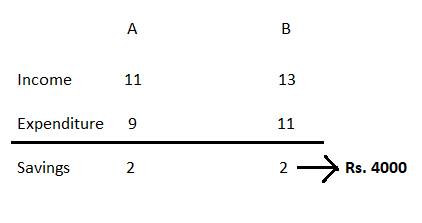Question
The ratio of the monthly incomes of A and B is 11: 13
and the ratio of their expenditures is 9: 11. If both of them manage to save ₹4,000 per month, then find the difference in their incomes (in ₹).Solution
Let, the monthly income of A = 11x The monthly income of B = 13x The monthly expenditures of A = 9y The monthly expenditures of B = 11y So, 11x - 9y = 4000 .....(1) 13x - 11y = 4000 .....(2) (1) × 11 - (2) × 9 gives, 121x - 99y - 117x + 99y = 44000 - 36000 ⇒ 4x = 8000 ⇒ x = 8000/4 = 2000 ∴ A's income = 11 × 2000 = Rs. 22000 ∴ B's income = 13 × 2000 = Rs. 26000 The difference of income = 26000 - 22000 = Rs. 4000 Alternate method  The difference = 2 ratio = Rs. 4000 Their income difference = 13 - 11 = 2 ratio ∴ Income difference = Rs. 4000 ∴ The difference between A and B's incomes (in Rs.) is Rs. 4000
The difference = 2 ratio = Rs. 4000 Their income difference = 13 - 11 = 2 ratio ∴ Income difference = Rs. 4000 ∴ The difference between A and B's incomes (in Rs.) is Rs. 4000
Which Section of Indian Evidence Act is founded on the doctrine laid down in “Pickard v Sears”?
Section 82 of the Negotiable Instrument Act, 1881 deals with _________.
Central Government departments must consult the CVC in matters involving:
Tort has been derived from the word_______.
Which of the Labour Code was enacted in 2019?
Section 2(20): “Company means a company incorporated under this Act or under any previous company law.” Consider:
(1) This definition covers ...
A mortgages to B a certain field bordering on a river. The field is increased by alluvion. B is:
Adjudicating Authority’s powers and functions are contained under which provision?
The provision as laid down under IPC provides that nothing is an offence which is done by a child under seven years of age is represented by which doctrine
As per Section 4A(1), the Director is appointed by the Central Government on the recommendation of a Committee consisting of:
Relevant for Exams:


